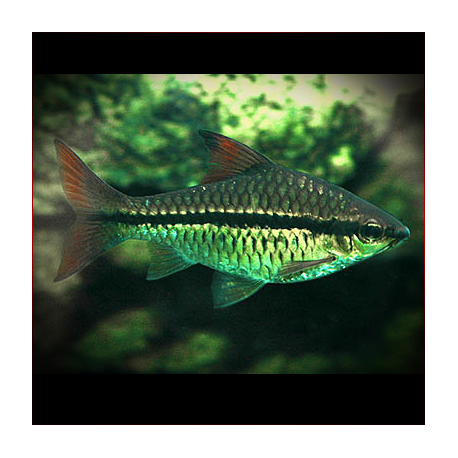More info
Datasheet
| Minimum Tank Size | 160 litres / 42.27 US gallons |
| Maximum Size | 10.0cm / 3.94inches |
| Temperature | 22°C / 71.60°F - 27°C / 80.60°F |
| Hardness | 2.02dgH / 36ppm - 12.05dgH / 215ppm |
| pH | 6.0-7.0 |
Behaviour
This species, Barbus Sublineatus, thrives in a peaceful community setting with slightly larger African species like other Barbus, Alestiid tetras, Mochokid catfish, and Ctenopoma. They can also coexist with bold, non-intimidated fish of a larger size, including cichlids like Hemichromis and South American species such as Geophagines. Being a schooling species, it is recommended to keep them in groups of 8-10 for a less skittish and more natural display, which also helps contain any aggressive behavior within the hierarchical group structure.
Feeding and Diet
Stomach analyses of wild Barbus Sublineatus show them to be generalist omnivores, feeding on various insects, invertebrates, and both terrestrial and aquatic plant materials. Their ideal diet in captivity consists of live and frozen foods like bloodworms, Daphnia, and Artemia, along with high-quality dried foods containing added vegetable content to ensure balanced nutrition for the fish.
Reproduction & Dimorphism
Information regarding the reproduction of Barbus Sublineatus in captivity is scarce. However, following strategies employed for similarly sized cyprinids is recommended for breeding attempts. Males of the species are distinguishable by more intense coloration, slimmer bodies, and slightly smaller sizes compared to females.
Habitat and Distribution
Inhabiting primarily rivers and streams, Barbus Sublineatus is found across Northwestern Africa in various river basins such as the Cavalla River, Comoé river, Volta River, and Niger Delta among others, encompassing regions like Guinea, Liberia, Ghana, Togo, Benin, Cameroon, Nigeria, Senegal, Mali, and Niger.
Aquarium Setup
Maintaining Barbus Sublineatus in a well-maintained tank is fairly undemanding, though they may appear less vibrant in sparsely decorated setups. To bring out their best colors, it is recommended to have good lighting, dark substrate, clean well-oxygenated water with a degree of flow, and a setup adorned with smooth rocks, twisted roots, and live plants as specified in the table with water conditions ideally within a hardness of 36-215 ppm, pH of 6.0-7.0, and temperature range of 22-27 degrees Celsius.

